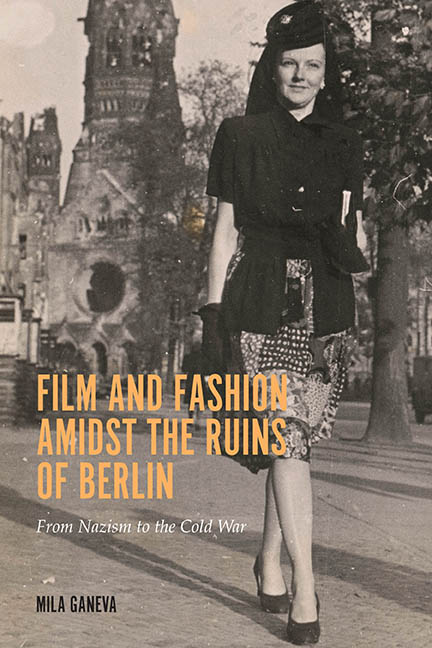Book contents
- Frontmatter
- Contents
- List of Illustrations
- Acknowledgments
- Introduction
- Chapter 1 Vicarious Consumption: Wartime Fashion in Film and the Press, 1939–44
- Chapter 2 “Fashions for Fräuleins”: The Rebirth of the Fashion Industry and Media in Berlin after 1945
- Vignette 1 Charlotte Glückstein: Historical Ruptures and Continuities in Postwar Fashion
- Chapter 3 Fashion amidst the Ruins: Revisiting Two Early Rubble Films,… und über uns der Himmel (1947) and Die Mörder sind unter uns (1946)
- Vignette 2 Hildegard Knef: Star Appeal from Fashion to Film
- Chapter 4 Farewell to the Rubble and Welcome to the New Look: Straßenbekanntschaft (1948) and Martina (1949)
- Chapter 5 Consuming Fashion on the Screens of the Early 1950s: Modell Bianka (1951), Frauenschicksale (1952), and Ingrid: Die Geschichte eines Fotomodells (1955)
- Epilogue
- Appendix 1 Principal Costume and Fashion Designers: Biographical Notes
- Appendix 2 Films and Newsreels Discussed
- Notes
- Bibliography
- Index
Chapter 3 - Fashion amidst the Ruins: Revisiting Two Early Rubble Films,… und über uns der Himmel (1947) and Die Mörder sind unter uns (1946)
Published online by Cambridge University Press: 28 July 2018
- Frontmatter
- Contents
- List of Illustrations
- Acknowledgments
- Introduction
- Chapter 1 Vicarious Consumption: Wartime Fashion in Film and the Press, 1939–44
- Chapter 2 “Fashions for Fräuleins”: The Rebirth of the Fashion Industry and Media in Berlin after 1945
- Vignette 1 Charlotte Glückstein: Historical Ruptures and Continuities in Postwar Fashion
- Chapter 3 Fashion amidst the Ruins: Revisiting Two Early Rubble Films,… und über uns der Himmel (1947) and Die Mörder sind unter uns (1946)
- Vignette 2 Hildegard Knef: Star Appeal from Fashion to Film
- Chapter 4 Farewell to the Rubble and Welcome to the New Look: Straßenbekanntschaft (1948) and Martina (1949)
- Chapter 5 Consuming Fashion on the Screens of the Early 1950s: Modell Bianka (1951), Frauenschicksale (1952), and Ingrid: Die Geschichte eines Fotomodells (1955)
- Epilogue
- Appendix 1 Principal Costume and Fashion Designers: Biographical Notes
- Appendix 2 Films and Newsreels Discussed
- Notes
- Bibliography
- Index
Summary
It is nice to look again at nice dresses even if one cannot wear them.
—Welt im Film, newsreel no. 45/5, February 1946THE IMMEDIATE POSTWAR YEARS witnessed the rapid rebirth not only of the clothing industry and the related media, but also of German film. Despite the dire historical and material circumstances, women's fashion continued to play a significant and very specific role in German postwar films. This chapter revisits two rubble films that have been rarely brought into dialogue with each other: Die Mörder sind unter uns (1946), the first DEFA production with a Soviet license, and its counterpart from the West, the much-anticipated first film produced under an American license … und über uns der Himmel (1947). The comparison between Die Mörder and Der Himmel and the critical reevaluation of press accounts from the same period, especially in women's and fashion publications, allow for the reconstruction of a historic female experience of the immediate postwar period that goes beyond the stereotypical media images of the German woman as Trümmerfrau, Amiflittchen, Fräulein, or a victim of rape. By taking a closer look at the presentation of women's clothes and various sartorial practices in these two films, this chapter delineates a much wider range of subjective positions associated with female characters and a broader array of attractive identities offered to a predominantly female spectatorship.
Rubble films (Trümmerfilme) have often been discussed in terms of their troubled reception by contemporaries. The approximately forty Trümmerfilme produced in the 1946–49 period often featured ruined cities, especially Berlin, as the backdrop and offered narratives of physical and psychological reconstruction after the demise of the Third Reich. Usually they disappointed contemporary critics. For example, the critic Friedrich Luft opined that some of the films failed to address adequately the moral conundrums of the postwar period, even though they were “bending under the lead weight of their political content.” Another irritant for some critics was the “forced symbolism” and everything that looked like a continuation of UFA style from the 1930s.
- Type
- Chapter
- Information
- Film and Fashion amidst the Ruins of BerlinFrom Nazism to the Cold War, pp. 83 - 104Publisher: Boydell & BrewerPrint publication year: 2018



